History of the Confederate Flag
The ‘Confederate flag’ waved today was never the official flag of the Confederate States of America. Rather, it was the flag of the Army of Northern Virginia. Quoted text is from an article written in History of Alabama and Dictionary of Alabama Biography before 1921 and Wikipedia
First Confederate flag
The first Confederate flag, popularly known as the “Stars and Bars,” was flung to the breeze on the fourth day of March, 1861, the day of its adoption by the provisional congress. In anticipation or the report of the committee and the formal adoption of a design, Hon. Alexander D. Clitheral had had one prepared from the model.
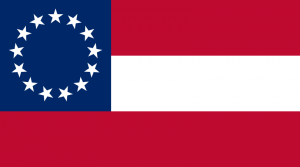 First Confederate flag designed by Nicola Marschall – flew from March 4, 1861 to May 1, 1863
First Confederate flag designed by Nicola Marschall – flew from March 4, 1861 to May 1, 1863
“The congressional action found its way into the city, a “large concourse of spectators assembled on capitol hill. Miss Letitia Christian Tyler, daughter of Col. Robert Tyler, and granddaughter of John Tyler ex-president of the United States, had been selected to raise the flag. The news account contained in the Montgomery Weekly Advertiser of March 6, gives this thrilling account: When the time had arrived for raising the banner, Miss Tyler steadily and with heart throbbing with patriotic emotion, elevated the flag to the summit of the staff, cannon thundered forth a salute, the vast assemblage rent the air with shouts of welcome, and the people of the south had for the first time a view of the southern flag.”
The history or genesis of the flag has in recent years been the subject of much investigation. The Confederate organizations have undertaken to make a declaration as to whom the honor or credit should be given. The journals of the Confederate congress contain many references to the subject. A committee on flags was appointed by congress to receive and consider all the designs submitted. Its report contains nothing to definitely determine the inquiry. However, the statement is made that the flag as adopted and reported was the work of the committee, and none of the designs sent by individuals as models having been thought suitable.” It is quite definitely determined, however, that the flag as adopted embodies in large part the suggestions submitted by Nicola Marechal, a distinguished portrait painter then residing at Marion, Perry County.
The flag recommended by the “Committee on a Proper Flag for the Confederate States of America,” appointed by the Provisional Congress, in its report of March 4th- 1861is as follows:
“That the Flag of the Confederate States of America shall consist of a red field with a white space extending horizontally through the center, and equal in width to one-third the width of the flag. The red space above and below to be of the same width as the white. The union blue extending from through the white space and stopping at the lower red space. In the center of the union a circle of white stars, corresponding in number with the States of the Confederacy.”
Note. The union is square; the stars five pointed. The length of the flag one and a half times the width.
As you can see this Confederate flag called the ‘Stars and Bars’ resembled the Federal flag, especially when it was hanging limp on the flagstaff, and this resulted in confusion on the battlefield so a new Confederate battle flag was designed.
Second flag.—The “Battle Flag,” known as the second flag, was designed by General Beauregard, adopted by General Joseph E. Johnston, after the first battle of Manassas (Bull Run), and afterward adopted by the Confederate Congress. The reason for its adoption was that in the smoke and dust of battle the “Stars and Bars” was frequently mistaken for the “Stars and Stripes.” 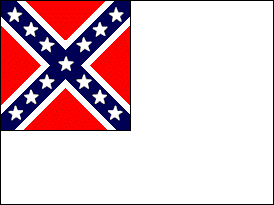
The second national flag of the Confederate States of America -sometimes called ‘The Stainless Banner” flew from May 1, 1863 – March 4, 1865
Initial reaction to the second national flag was favorable, but over time it became criticized for being “too white”. The Columbia-based Daily South Carolinian observed that it was essentially a battle flag upon a flag of truce and might send a mixed message. Military officers also voiced complaints about the flag being too white, for various reasons, such as the danger of being mistaken for a flag of truce, especially on naval ships, and that it was too easily soiled.
Third Flag.—The third in the series was adopted by the Confederate Congress, May 1, 1863, as the “National Flag” of the Confederate States.
The third national flag (also called “the Blood Stained Banner”) was adopted March 4, 1865. The red vertical bar was proposed by Major Arthur L. Rogers.
Fourth Flag.—A modification of the third flag was adopted March 4, 1865, as the “National Flag” of the Confederate States, by the Confederate Congress. The red outer border and was thus added and the canton was square.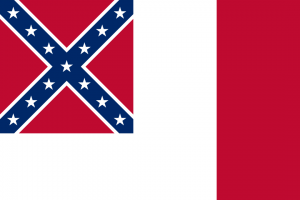
Given that the Confederacy fell within a few months of the adoption of the “Blood-Stained Banner,” very few flags of this design were manufactured or used.
“In addition to the national flags of the Confederacy, a wide variety of flags and banners were flown by Southerners during the War. Most famously, the “Bonnie Blue Flag” was used as an unofficial flag during the early months of 1861. It was flying above the Confederate batteries that first opened fire on Fort Sumter in Charleston harbor, in South Carolina beginning the Civil War.”
The Army of Northern Virginia battle flag was square, of various sizes for the different branches of the service: 52 inches (130 cm) square for the infantry, 38 inches (97 cm) for the artillery, and 32 inches (81 cm) for the cavalry. It was used in battle beginning in December 1861 until the fall of the Confederacy. The blue color on the saltire in the battle flag was navy blue, as opposed to the much lighter blue of the Naval Jack.
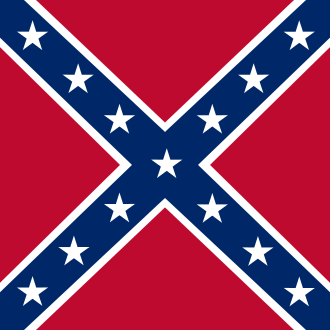 The Battle flag of the Army of Virginia
The Battle flag of the Army of Virginia
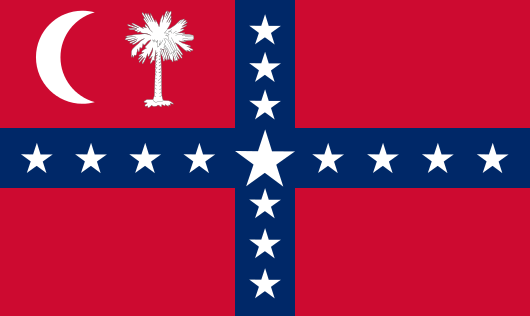 South Carolina Sovereignty/Secession Flag with the decrescent moon and the palmetto in the left corner
South Carolina Sovereignty/Secession Flag with the decrescent moon and the palmetto in the left corner
A very good article on the myths and truths surrounding the Confederate flags can be found at Snopes.com
SOURCES
- History of Alabama and Dictionary of Alabama Biography – from: T. C. De Leon, Four Years in Rebel Capitals (1890), chapters Ml; Smith, History and Debates of the Secession Convention (1861); Confederate States of America, Journals of the Congress of (1904), vol. 1, index; Ordinances and Constitution of Alabama, with Constitution of the Confederate States of America (1861); United States War Department, Executive and Congressional Directory of the Confederate States, 1861-1865 (1899); Thomas M. Owen, “Formation of Southern Confederacy, February 4, 1861,” in the Montgomery Advertiser, February 5, 1911; Mrs. Jefferson Davis, Jefferson Davis, A Memoir (1890), vol. 2, chapters 1-9; Selma Morning Reporter, April 13, 16, 1861; Montgomery Weekly Advertiser, March 6, April 17, May 15, May 22, 1861; Confederate States Statutes at Large, 1861-62, vol. 1. index.
- Wikipedia
- Snopes.com
ALABAMA FOOTPRINTS Exploration: Lost & Forgotten Stories (Volume 1) is a collection of lost and forgotten stories about the people who discovered and initially settled in Alabama.
First Mardi Gras in America
The Mississippi Bubble Burst
Royalists settle in Alabama
Sophia McGillivray- A Remarkable Woman


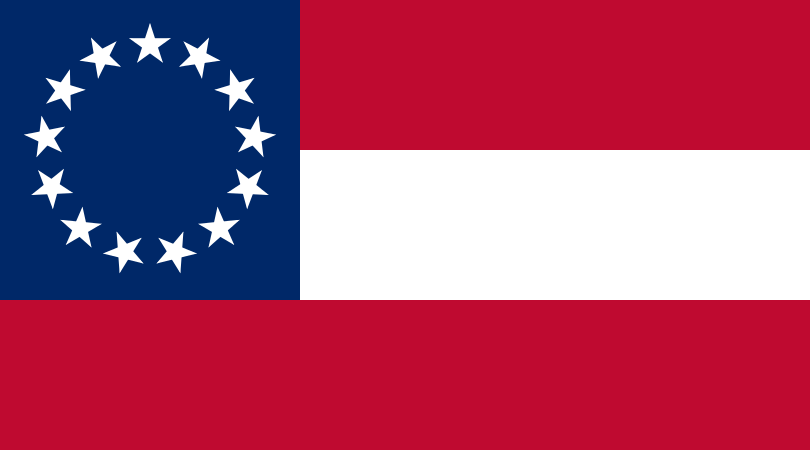
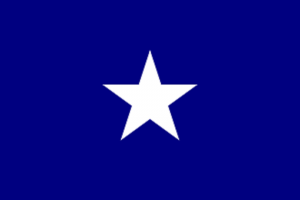
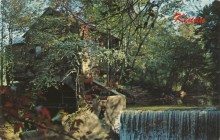
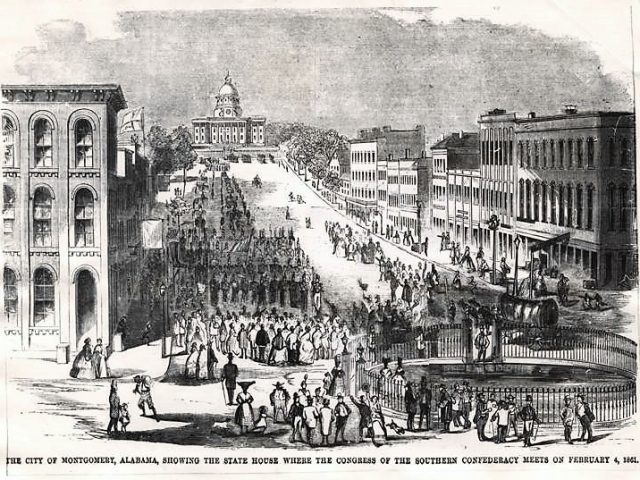
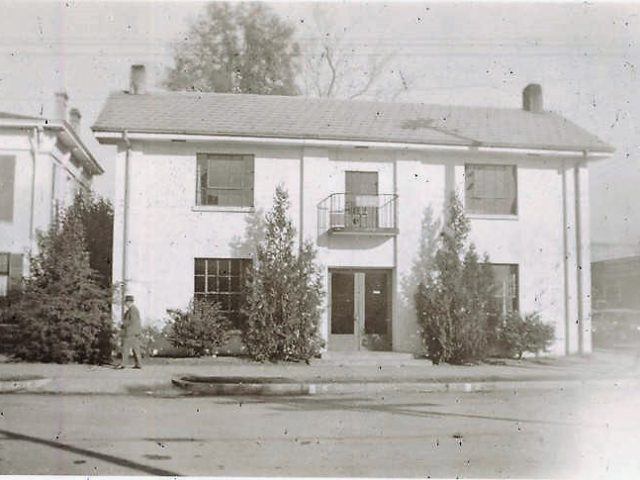
One more time to educate you Damn idiots
Our county historical society has what may be the first National Flag (Bonnie Blue) captured in the War at I blieve was Rich Mountain in western Virginia. It was on display at our county courthouse at one time. One day when I was studying it, another couple looked at it and he told his wife that it was a British Flag. They didn’t believe me when I explained to them what it was. Hmmmm. Fly this one and no one will even know. HAHAHAHAHAHA!
Tell that to the kkk and white supremacists.
Three Confederate national flags, not four. The third and fourth flags listed in the article are the same flag, which was adopted in 1865. If I remember correcfly, the adoption of the “blood-stained banner” was the last official act of the Confederate Congress before its dismissal and the evacuation of Richmond.
A woman in my shop mentioned the amount of people driving around flying the battle flag, she said it was disgusting and told me about one pickup truck with two flags flying, a white flag with a red stripes from corner to corner, I told her that was the Alabama state flag, also called the cross of St. Andrew. She did not believe me and thought it must be some hate flag, this woman was in her late 60’s and I could not belive she had never seen the state flag before. Scary !
The flag shown at the top of the article and listed as the first flag in incorrect, the first Confederate National flag only had 7 stars in a circle representing the 7 states that seceded from the Union, Alabama, Florida, Georgia, Louisiana, Mississippi, South Carolina and Texas, it flew from 4 Mar 1861 – 21 May 1861. A similar flag but with 9 stars flew from 21 May 1861 – 2 Jul 1861, followed by an 11 star flag, 2 Jul 1861 – 28 Nov 1861, and finally the 13 star flag, 28 Nov 1861 – 1 May 1863.
The flag shown at the top of the article and listed as the first flag in incorrect, the first Confederate National flag only had 7 stars in a circle representing the 7 states that seceded from the Union, Alabama, Florida, Georgia, Louisiana, Mississippi, South Carolina and Texas, it flew from 4 Mar 1861 – 21 May 1861. A similar flag but with 9 stars flew from 21 May 1861 – 2 Jul 1861, followed by an 11 star flag, 2 Jul 1861 – 28 Nov 1861, and finally the 13 star flag, 28 Nov 1861 – 1 May 1863. Also the first Confederate Naval jack was solid blue with 7 stars in a circle. So there were more than four official flags.
The folks that are hatin are completely ignorant and stubborn.
Folks are giving the kkk and white supremacists credit for knowing the truth about southern flags????? Really?? Let the ignorant remain ignorant
Yep…A Daughter of The Confederacy knows these things 😉
We used to have an album of Civil War songs. North on one side of album and South on the other.
One of the songs I remember was “The Bonnie Blue Flag” that bears the single star!!
[…] History of the Confederate Flag – There were actually four official Confederate flags […]
[…] History of the Confederate Flag – There were actually four official Confederate flags […]
[…] History of the Confederate Flag – There were actually four official Confederate flags […]
Thank you for this informative article on Confederate flags and your courage to Buck-The-Trend to support/preserve our wonderful Confederate history and Southern traditions.
Snopes and Wikipedia are not credible sources for information of any kind but opinions and buzzwords.
Seriously.